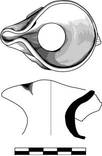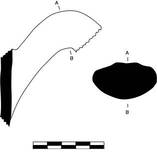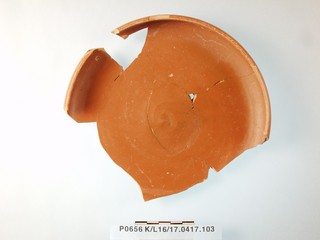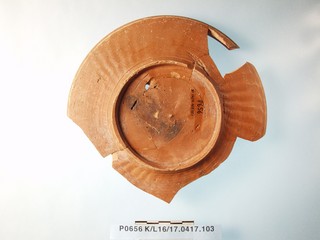Greek, Roman and Byzantine Pottery at Ilion (Troia):
Sebastian Heath and Billur Tekkök, Editors
Late Third Century Cleanup (K/L16/17.0417)
Please note that this is a public draft of work in progress
Clean-up after collapse of Trajanic Complex, perhaps associated with Herulian disturbance. The combination of a well-preserved ESC/Candarli Hayes form 4, African Red-Slip Hayes form 45, and a painted thin-wall cup dates this assemblage to the late third century. Many of the cataloged sherds can be residual, though they do reflect the types of pottery available at Ilion at the time that this deposit closed. The Middle Roman Amphora 7-type handle is interesting because its highly-micaceous fabric can indicate a south-west Anatolian source related to the workshops producing "Micaceous Water Jars" (MRA/LRA3).
1. Çandarli Hayes Form 4 Profile (200-300)
H. .033. Est. diam. rim .17 (1/2 preserved). Th. .002.
K/L16/17.0417.103. P0656. Five joining fragments preserving complete profile. Fine red (2.5YR 7/6) fabric with occasional small white inclusions and more common small voids. All surfaces carry a dark red (between 10R 5/8 and 4/8) slip. The interior is smoothed though visibly thinner in places and the same treatment is applied to the rim above the carination. Below that the slip is more often thinner and less smooth. The body of the vessel here shows both scratches as well as irregular radial ridges – “turning mards” - that may be intentional but may also be the result of a too lightly applied smoothing instrument. There is a light smoothing spiral near the center of the floor on the interior.
p. 78, pl. XVIII.4.
svg/P0656.jpg
2. Çandarli Hayes Form 4 Rim (200-300)
P. H. .029. Est. diam. rim .19 (<1/12 preserved). Th. .003.
K/L16/17.0417:15. Single sherd. Compact light red (2.5YR 6/8) fabric with occasional light inclusions. Slip is poorly preserved but was dark red.
svg/K-L16-17.0417-15.jpg
3. Çandarli Hayes Form 4 Base (200-300)
P. H. .016. Est. diam. base .12 (<1/10 preserved). Th. .0025.
K/L16/17.0417:7. Single sherd. Compact light red (near 2.5YR 6/6) fabric with lime as well as tiny black inclusions. Smooth but somewhat unevenly applied red (between 10R 5/8 and 4/8) slip on preserved interior. Much thinner slip on exterior, which also shows scratch marks.
svg/K-L16-17.0417-7.jpg
4. Unclassified/Regional Thin-wall Cup/Jug Base
P. H. .029. Est. diam. base .036 (complete preserved). Th. .0025.
K/L16/17.0417:11. Single sherd with complete base. The fine fabric is unevenly fired to brown (2.5YR 5/6 and browner) with frequent small white inclusions and occasional mica on surface. The surface near the base is dirty brown (2.5YR 5/4) with the beginnings of a “gray zone” starting at .018 above the bottom of the vessel. This part is fired very weak red-brown (2.5YR 5/2). A band of .0045 high white dots, of which 7 are at least partially preserved, separates the lower lighter colored area from the higher, darker one.
Dotted decoration is well-known on thin-walled vessels. Cf. fig. 4.7m and plate 40j. Cf. FiE VIII/6 K749
svg/K-L16-17.0417-11.jpg
5. Unclassified/Regional Thin-wall Cup/Jug Base, Gray-on-Orange
P. H. .041. Est. diam. base .039 (complete preserved). Th. .002.
K/L16/17.0417:12. Two joining sherds preserve complete base. Compact red (2.5 YR 6/8) fabric with tiny white inclusions. The “gray zone” begins .014 above bottom of vessel.
svg/K-L16-17.0417-12.jpg
6. African Red-Slip Hayes Form 45a Rim (230-320)
Est. diam. rim near .30 (<1/20 preserved). Th. .004.
K/L16/17.0417:8. Single, small rim sherd. Compact, hard, well-fired light-red (near 2.5YR 6/6) fabric with only tiny inclusions. Thick bright reddish-orange (just redder than 2.5YR 5/8) slip on all surfaces. Single row of rouletting extant on upper surface of rim, with single incision just inside of outer edge. Body sherd K/L16-17.0417:9 is identical in details of fabric and surface treatment.
For form see p. 62.
svg/K-L16-17.0417-8.jpg
7. African Red-Slip Hayes Form 45a Base (230-320)
P. H. .007. Est. diam. base .11 (<1/20 preserved). Th. .003.
K/L16/17.0417:5. Small base sherd. Slightly granular fabric, sherd discolored by burning. A band of rouletting is partially preserved on the interior just inside the circumference of the base.
For form see p. 62.
svg/K-L16-17.0417-5.jpg
8. African Red-Slip Hayes Form 45a Base (230-320)
P. H. .008. Est. diam. base .11 (<1/10 preserved). Th. .0035.
K/L16/17.0417:6. Small base sherd. Slightly granular fabric. Thick slip on all extant surfaces.
For form see p. 62.
svg/K-L16-17.0417-6.jpg
9. Regional Sanded-Oxydized Cooking Ware Thin-Walled Cookpot, Downturned Rim
P. H. .042. Est. diam. rim .21 (1/5 preserved). Th. .003.
K/L16/17.0417:4. Single sherd. Compact red (2.5 YR 6/8) fabric with occasional tiny white inclusions. Gray surface.
Cf. T88 and T89.
svg/K-L16-17.0417-4.jpg
10. Regional Sanded-Oxydized Cooking Ware Trefoil-Mouth Jug
P. H. .045. Est. diam. rim length mouth .065 (completely preserved preserved). Th. .01.
K/L16/17.0417:10. Single sherd preserves complete mouth and handle attachment. Compact red (2.5YR 5/8) fabric with frequent small white inclusions. Exterior surfaces fired gray (7.5YR 5/1) interior plain.
svg/K-L16-17.0417-10.jpg
11. Gritty Gray Cookingware Flanged Casserole
P. H. .042. Est. diam. rim .21 (1/10 preserved). Th. .008.
K/L16/17.0417:14. Single sherd preserves <1/10 rim circumference. P.H. .042, est. D. rim near .22, Th. wall .008. Single rim sherd. Coarse brown (7.5YR 4/4) fabric with frequent large angular white chunks and smaller angular light and dark bits. Surface is coated reddish-brown (2.5YR 5/3 and lighter).
Cf. P51.
svg/K-L16-17.0417-14.jpg
12. Middle Roman Amphora 7 Type Handle
K/L16/17.0417:3. Handle with adjacent neck. P.H. .095, Th. across handle .046. Somewhat coarse brown (5YR 6/6) fabric with frequent angular white inclusions and much silver mica. Surface thinly coated but near color of fabric. The mica suggests an southwest Anatolian origin.
, pp. 189-193; 77; class 47.
svg/K-L16-17.0417-3.jpg













